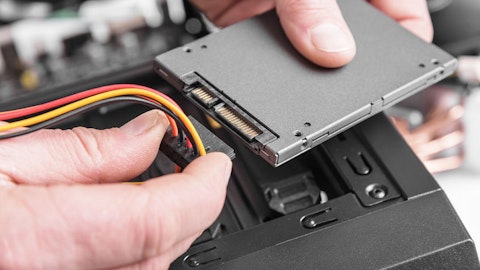York Ragen: And I know that there’s a lot of discussion on hard landing, soft landing recession, whatever it may be. And I think to Aaron’s point then as long as there’s power outages, we’ve historically tended to decouple from that economic environment as long as it power outages. So that’s — put it back to full circle to what — how Aaron started the answer to that question.
Operator: And our next question comes from Jeff Hammond from KeyBanc Markets.
Jeff Hammond: So just want to go through the — one, just the bridge on the margins, first half to second half, and how you get there. And I guess on a full year basis, it seems like EBITDA margins are kind of flattish to slightly down. And just given the revenue decline and the mix change, given home standbys under more in pressure, just some of the moving pieces on how to kind of hold those margins flat?
York Ragen: So speaking to EBITDA margins. So we mentioned Q1 would be in that 10% range. The double hit of the destock, coupled with a tough comp from the prior year, but looking at 10% EBITDA for Q1. Talked about Q4, building out through the year to Q4 being in that low 20% range. So you’re right, that’s an abnormally larger EBITDA range progressing through the year. But I think given some of the things that Aaron talked about, that’s the rationale for it. And when you look at a lot of the pieces, I mean, half of that growth just alone half of that growth, as home standby recovers in the back half, you’ll get a better mix in Q4 than you did in Q1 of home standby. You’ll get a tremendous amount of operating leverage then on the higher volumes.
So I would say just half of the margin recovery is just better mix and operating leverage on the higher home standby volumes. And then the other half is really a story on cost. So we’re currently realizing on a leg basis, we’re still realizing higher input costs, higher commodity costs, higher logistics costs, because there’s legs to get through our supply chain and legs to get through our inventory levels in terms of realizing our input costs. So when you model it out, we expect as we get through Q4 relative to Q1, we’ll have lower commodities, we’ll have lower electronic surcharges that we’ve been incurring all throughout 2022, lower logistics costs, the better manufacturing overhead absorption as we ramp up productions. And then we always have our profitability enhancement programs that we’re working on every year that are focused on cost reductions of the bill of material of our products, focused cost reductions, cross functional initiatives, things like that.
So on the cost side, that’s the other half of the puzzle. And we feel confident as we work through the legs, we’ll see better margins relative as a result of better input costs.
Operator: And our next question comes from Christopher Glynn from Oppenheimer. Christopher, is your line on mute, please unmute. And our next question comes from Mark Strouse from JPMorgan.
Mark Strouse: I wanted to turn to the Clean Power business. I apologize if I missed this. Did you say what that revenue number was in ’22, and then how should we think about that range kind of heading into 2023? And then I’m kind of also curious, I know you’ve got a lot of things going on that are company specific. How are you thinking about kind of the macro environment for that business in particular? Just hearing some kind of mixed commentary from some of the other companies in the space.
York Ragen: So that energy technology business, which includes the Clean Energy, PWRcell energy storage business, our ecobee connected devices business and grid services business, that was around $300 million for the year. And I think in Aaron’s prepared remarks, we expect that same energy technology business to be around $300 million to $350 million for 2023.
Aaron Jagdfeld: And then from a macro standpoint, Mark, the way we see this space, obviously, we’re in this for the long run. And so from a macro environment standpoint, I think there’s a number of forecasts out there they’re calling for residential solar to maybe be down in ’23. And there’s a couple of reasons for that, obviously, higher interest rates. As part of that story, another part of that story, would be some of the changes that are ongoing kind of at the state level, you look at like California with NEM 3.0 and the impact that, that can have on the pace of solar penetration rates, I would say, that’s largely — there’s a view that that’s largely offset by some of the federal stimulus that the IRA Act is providing. So we remain bullish that while growth maybe isn’t going to be huge, as York said, between $300 million and $350 million, which is a little bit of growth over the prior year.
But we are seeing, at least within our network for the Clean Energy side, again, we’ve got some specific company challenges, as you mentioned, that we’re working through. But on our connected devices businesses, specifically ecobee, seen really nice growth in that business as well as grid services, like we mentioned in our prepared remarks this morning. So that all kind of goes under this umbrella that we refer to as residential energy technology, put together the Clean Energy devices, connected devices and grid services. So not tremendous growth in ’23 but we see the opportunity for that business long term. It’s an important strategic part of what we need to build out, and we’re going to be successful there longer term.
Operator: And for our next question, we have Brian Drab with William Blair.
Brian Drab: I was wondering if you could just elaborate on the EV charging opportunity. Can you say anything about what you think the revenue opportunity might be there longer term, and are you essentially leveraging the PWRcell technology to build that product?
Aaron Jagdfeld: We’re really excited about this. We’re the first generation product, I’ll call it, that we’re launching this year is more of a standard level two charger that we’ll have in the market by later this year. We really want to get something in the hands of our distribution partners, in particular, our dealer partners who are starting to see more opportunities for EV charger implementation. The team is really focused — longer term, we believe there’s some innovation there. As you kind of indicate, the current architecture we have with our PWRcell system, the rebus architecture, as we refer to it, that we have, we think there’s a great opportunity to do more with EV charging and really to separate ourselves from a technical standpoint longer term.
That won’t be the initial product. But the initial product is going to, again, get us in the space. We do think there’s some opportunities around the initial product to help homeowners manage the different loads in their homes so that they can maybe avoid a costly upgrade of their electrical system. One of the things that many homeowners are confronting as they look at an EV charger, look at buying an EV is it’s not just that they have to install the charger, which can cost $1,000, $1,500, but they also have to oftentimes upgrade their electrical system, because their panel is either deficient in the amount of power that it can supply or perhaps it’s not up to code. So in fact, some of the installation partners are telling us that 60% of the time when they’re installing a charger, they have to do some major electrical work around upgrading the panel.
We think there’s an opportunity with some of our PWRmanager technology to help homeowners manage some of the heavier loads and avoid some of those more expensive panel upgrades and electrical upgrades. So that’s going to be part of our value proposition around EV charging initially here. And then longer term, we think there’s some pretty exciting things perhaps around bidirectional charging. As that market matures, we think we can really add some value there for homeowners. In particular, when you think of the EV charger in the context of one component in the broader home energy ecosystem, we think that that’s going to be at the very large load for the home and being able to control that load, both from an efficiency standpoint as well as a cost standpoint, it’s going to be super critical to how homes manage their overall energy generation, their storage and all of their resiliency efforts as well longer term.
Operator: And our next question comes from Jerry Revich from Goldman Sachs.
Jerry Revich: Aaron, I’m wondering if you could just expand on the comments regarding 20% decline in field inventory. So in the 10-Q, you folks disclosed $220 million of dealer financing guarantees on inventories. So is that 20% applied to that $220 million? In other words, are you under shipping end demand by $40 million in the fourth quarter, or is that a subset of the overall dealer inventory picture that you look at?
York Ragen: So yes, that disclosure that you’re speaking to on the field, the floor plan financing program is just a subset of our field inventory that
Aaron Jagdfeld: Field inventory is across all channels, right
York Ragen: All channels…
Aaron Jagdfeld: e-commerce partners
York Ragen: And not everybody, and even the dealers not everybody uses the field floor plan financing. So it’s subset. It is improving that number off the peaks. So again, if you just look at raw units across the entire subset based on the information we track with all the data we have, just raw units were down 20% from peak levels from earlier this year — earlier in middle part of 2022.
Operator: And our next question comes from Joseph Osha from Guggenheim.
Joseph Osha: Just penciling through what you said so far and looking at the — in particular, how residential energy tech is trending. It looks to me like somewhere around Q3 for this to work you need your HSB business to see a 30% or so sequential increase Q2 to Q3, or is that of the whole year guidance?
York Ragen: Well, you definitely would need — you will definitely see a sequential — a larger than normal sequential increase from Q2 to Q3 in home standby, just because you won’t have the field inventory overhang. And so that’s an artificial reduction in the first half
Aaron Jagdfeld: And then there’s some normal seasonality that takes place.
York Ragen: Yes, you had normal seasonality
Aaron Jagdfeld: Right. The season for home standby generators typically picks up in the third and fourth quarter.
York Ragen: You would expect to see a sizable increase in home standby if that’s what you’re interpreting from our comments, yes.
Operator: And our next question comes from Donovan Schafer from Northland Capital Markets.





